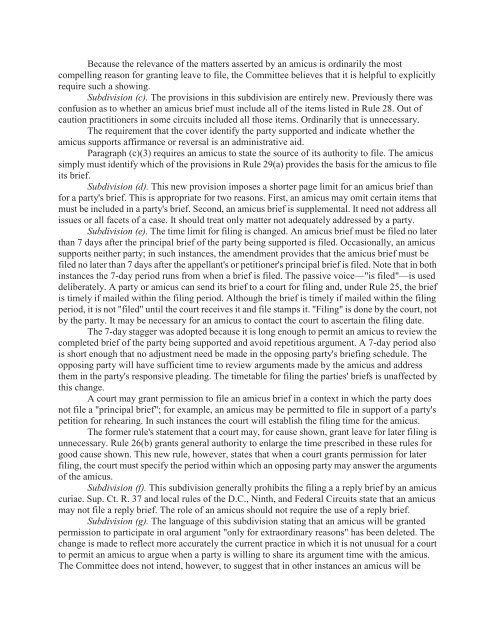Federal Rules of Appellate Procedure 2014-2015, 2014a
Federal Rules of Appellate Procedure 2014-2015, 2014a
Federal Rules of Appellate Procedure 2014-2015, 2014a
You also want an ePaper? Increase the reach of your titles
YUMPU automatically turns print PDFs into web optimized ePapers that Google loves.
Because the relevance <strong>of</strong> the matters asserted by an amicus is ordinarily the most<br />
compelling reason for granting leave to file, the Committee believes that it is helpful to explicitly<br />
require such a showing.<br />
Subdivision (c). The provisions in this subdivision are entirely new. Previously there was<br />
confusion as to whether an amicus brief must include all <strong>of</strong> the items listed in Rule 28. Out <strong>of</strong><br />
caution practitioners in some circuits included all those items. Ordinarily that is unnecessary.<br />
The requirement that the cover identify the party supported and indicate whether the<br />
amicus supports affirmance or reversal is an administrative aid.<br />
Paragraph (c)(3) requires an amicus to state the source <strong>of</strong> its authority to file. The amicus<br />
simply must identify which <strong>of</strong> the provisions in Rule 29(a) provides the basis for the amicus to file<br />
its brief.<br />
Subdivision (d). This new provision imposes a shorter page limit for an amicus brief than<br />
for a party's brief. This is appropriate for two reasons. First, an amicus may omit certain items that<br />
must be included in a party's brief. Second, an amicus brief is supplemental. It need not address all<br />
issues or all facets <strong>of</strong> a case. It should treat only matter not adequately addressed by a party.<br />
Subdivision (e). The time limit for filing is changed. An amicus brief must be filed no later<br />
than 7 days after the principal brief <strong>of</strong> the party being supported is filed. Occasionally, an amicus<br />
supports neither party; in such instances, the amendment provides that the amicus brief must be<br />
filed no later than 7 days after the appellant's or petitioner's principal brief is filed. Note that in both<br />
instances the 7-day period runs from when a brief is filed. The passive voice—"is filed"—is used<br />
deliberately. A party or amicus can send its brief to a court for filing and, under Rule 25, the brief<br />
is timely if mailed within the filing period. Although the brief is timely if mailed within the filing<br />
period, it is not "filed" until the court receives it and file stamps it. "Filing" is done by the court, not<br />
by the party. It may be necessary for an amicus to contact the court to ascertain the filing date.<br />
The 7-day stagger was adopted because it is long enough to permit an amicus to review the<br />
completed brief <strong>of</strong> the party being supported and avoid repetitious argument. A 7-day period also<br />
is short enough that no adjustment need be made in the opposing party's briefing schedule. The<br />
opposing party will have sufficient time to review arguments made by the amicus and address<br />
them in the party's responsive pleading. The timetable for filing the parties' briefs is unaffected by<br />
this change.<br />
A court may grant permission to file an amicus brief in a context in which the party does<br />
not file a "principal brief"; for example, an amicus may be permitted to file in support <strong>of</strong> a party's<br />
petition for rehearing. In such instances the court will establish the filing time for the amicus.<br />
The former rule's statement that a court may, for cause shown, grant leave for later filing is<br />
unnecessary. Rule 26(b) grants general authority to enlarge the time prescribed in these rules for<br />
good cause shown. This new rule, however, states that when a court grants permission for later<br />
filing, the court must specify the period within which an opposing party may answer the arguments<br />
<strong>of</strong> the amicus.<br />
Subdivision (f). This subdivision generally prohibits the filing a a reply brief by an amicus<br />
curiae. Sup. Ct. R. 37 and local rules <strong>of</strong> the D.C., Ninth, and <strong>Federal</strong> Circuits state that an amicus<br />
may not file a reply brief. The role <strong>of</strong> an amicus should not require the use <strong>of</strong> a reply brief.<br />
Subdivision (g). The language <strong>of</strong> this subdivision stating that an amicus will be granted<br />
permission to participate in oral argument "only for extraordinary reasons" has been deleted. The<br />
change is made to reflect more accurately the current practice in which it is not unusual for a court<br />
to permit an amicus to argue when a party is willing to share its argument time with the amicus.<br />
The Committee does not intend, however, to suggest that in other instances an amicus will be


















